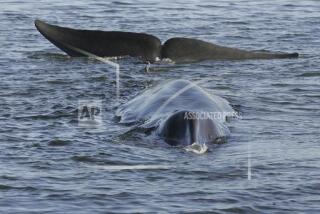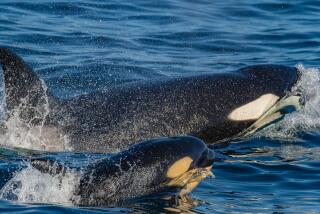Faroe Islanders Continue Whale Hunts
- Share via
TORSHAVN, Faroe Islands — Faroese have hunted whales since the 12th Century, and swear they will continue despite criticism heightened by news photos of women and children helping butcher the beached mammals.
They kill for food, not commerce.
A pilot whale can feed a village for months. The rich meat, often wind-dried and eaten in thin slices with salted blubber, is a staple of the diet on this volcanic archipelago midway between Scotland and Iceland.
Hunters drive herds of pilot whales into shallow bays for the kill. Conservationists and animal rights groups say the summer and fall hunts are wasteful and inhumane, but they are a way of life to the 47,000 islanders.
“We were called ‘bloodthirsty barbarians’ and the hunt ‘a ritual-blood sport,’ ” said Kjartan Hoydal, director of fisheries in Torshavn, the Faroese capital.
Hoydal said that description is wrong.
“The difference with other whaling is that the pilot-whale drive is noncommercial,” he said in an interview. “We kill for our own consumption and no more.”
The Faroese have kept detailed records of the hunt since 1584, and the island government says there are 100,000 pilot whales around these Danish islands and Iceland. The yearly harvest by Faroese is 1,000 to 2,000.
“Even though they are not endangered, it’s a matter of principle for us to have the islanders stop the pilot whale killings,” said Jens Ole Hojmann, a maritime ecology campaigner for Greenpeace in Copenhagen, the Danish capital. “It’s a matter of keeping the ecological balance whole.
“We reject the argument that it’s an old traditional hunt when you look at the Faroese society, with a high standard of living and driving around in large cars.”
There is no hunting season, but most of the killing takes place from June to September, when there is abundance of squid, the favorite food of pilot whales.
From lookouts atop the sheer cliffs, spotters search for herds of whales, which can number from 20 to 2,000.
A herd is sighted and, “Grindahvalur!” The word goes out by telephone and radio.
“We drop whatever we’re doing and rush to the boats,” said Petur Gunnarson, a 62-year old fisherman.
Islanders maneuver their small motorboats into a wide semi-circle and drive the whales into the nearest of 21 bays authorized for the kill. After the whales are grounded in the shallows, men with foot-long knives jump into the waist-deep water, cut arteries behind the head and slit the neck.
If the whales are too far from shore, gaffs are used to drag them closer.
Carcasses are pulled from the bloodied water, cut up and divided among villagers according to written rules dating back from 1298.
Pilot whales grow to about 23 feet in length and often weigh more than 4,000 pounds.
About one-fourth of the islanders’ annual meat supply comes from the whales, according to official statistics.
In response to international and local protests, the Faroese Parliament banned commercial whaling in territorial waters in 1985.
The same legislation outlawed the use by hunters of harpoons and spikes, which were condemned for causing the whales unnecessary suffering and prolonged agony. Only long knives and gaffs are permitted.
Justinus Olsen, a veterinarian, said the gaff “has been widely criticized for causing unnecessary suffering, and we ask the hunters to use it as little as possible. The killing is more humane and quicker than before.”
Guns have been tried, Olsen said, “but we need big calibers to kill instantly and they are too heavy to carry in the cold waters.”
A group of hunters armed with knives can kill several hundred whales in 10 minutes.
Only men take part in the kill, but women and children help with the butchering on shore.
“There are no professional hunters,” and the older generation passes on the skill to the young, Hoydal said.
Hojmann of Greenpeace remains optimistic.
“I think it’s a matter of a couple of generations before they drop the pilot whale hunt,” he said. “The younger generations are losing interest.”
More to Read
Sign up for Essential California
The most important California stories and recommendations in your inbox every morning.
You may occasionally receive promotional content from the Los Angeles Times.













